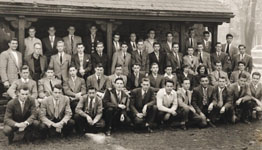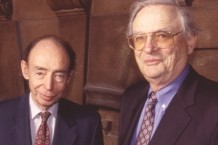The class of 1952 has long regarded itself as the first class to graduate from the modern Faculty of Law at U of T. However, this claim does not go undisputed. The class of 1951 has also laid claim to that title, and reminded us of that fact at their 55th class reunion dinner, held in November 2001.
Which class is right? As it turns out, they both are.

First-year class of 1947, School of Law, University of Toronto
The class of 1952 was the first class to be directly admitted into Dean Caesar Wright’s new law school in 1949. They graduated three years later, in 1952. However, by an extraordinary and fortuitous set of events, the class of 1951, which started in Dean W.P.M. Kennedy’s law school in 1947, was in fact the first class to graduate from Dean Wright’s new law school in 1951, although not admitted directly into it. What follows is their remarkable story.
In 1947 Marvin Arnold, Irwin Cass, Bill Sherwood, Bernard Burton, Leonard Fine, Gordon Landig, Al Stevenson, Jack Norman, Martin Eisen, and Murray Thompson, along with nearly 50 other young men and a handful of women, were just beginning their first year at the well-established University of Toronto “School of Law”. Four years later, with just these 10 of the original group remaining, the “Class of 1951” was about to become part of Ontario legal history and the first class to graduate from the newly formed U of T Faculty of Law.

Marvin Arnold (left) and Irwin Cass
“We had no real awareness of the changes to come” says Arnold. “We were just eager to learn as much law as we could before entering the Law Society’s practical course for admission to the Bar,” adds Cass.
At that time, the sole route to becoming a lawyer in Ontario was through the Law Society of Upper Canada, the governing body of the legal profession in Ontario, which operated a school at Osgoode Hall and required a general bachelors degree for admission. There, the law program consisted of three (and later four) years of on-the-job training complemented by a few law courses.
In marked contrast to the Law Society’s professional trade school, the U of T School of Law, as it was called at that time, offered a four-year Hons. B.A. in Law under the leadership of Dean, W.P.M. Kennedy. “We wanted to learn the law from a more academic approach – and all of us benefited enormously from the intellectual discussions that took place daily,” says Cass.
“We particularly enjoyed learning legal subjects under Dean Kennedy,” adds Arnold, who remembers him fondly as a fiery Irishman and strong constitutionalist.
Throughout the late 1940s these two distinct visions of legal education continued to percolate in the legal and academic communities. The mounting tensions came to a head in 1949 with a clash of opinions between the Benchers of the Law Society, and the now legendary Cecil (‘Caesar’) Wright, who was the newly named dean of Osgoode. Like Kennedy, Wright believed ardently in a solid academic grounding for lawyers, and differed with the Law Society’s more practical approach.
In a standoff of opinions, Wright resigned his position as dean and accepted an offer from U of T President Sydney Smith to join U of T law school (following Kennedy’s retirement).
He brought with him legal giants, Bora Laskin and John Willis. “We called them the great triumverite,” remembers Cass. “They were, even then, known to be the best in their field, and we felt fortunate to be given the opportunity to learn under them.”
In Wright’s first year as dean he started a new three-year LL.B. program. Cass, Sherwood and Arnold had just completed two years of Kennedy’s four-year B.A. in Law.
“We were anxious to know how our two years would fit into Wright’s new program,” remembers Arnold.
“The question on everyone’s mind was what to do,” adds Cass.
That question was quickly answered. Wright offered the class the option of continuing in Kennedy’s bachelors program, or switching to the second year of his new program. All but one took up his offer to join the LL.B. program.
A Broader Legal Education
Once at U of T, Wright and his colleagues continued to stress the need for a broader academic component to legal education, and for the educational process to be developed and controlled by professional educators.
“Wright was always inviting well known legal academics to add to our law program,” says Sherwood. “It really enriched the learning environment and added an intellectual vibrancy that was second to none."
All three men agree that Wright, Laskin, and Willis were excellent teachers who offered their students small seminar classes with stimulating debates and intellectual discussions. “Willis was a real standout,” says Cass.
“He was enthusiastic and engaging – a real teachers’ teacher,” agrees Arnold.
More Challenges Ahead
In 1951, with four solid years of legal training and an LL.B., they became the first class to graduate from Dean Caesar Wright’s newly formed Faculty of Law. However, more challenges lay ahead for this class.
“Wright believed that the Law Society would recognize his law program and allow us to go directly into the third year of its four-year training course,” says Sherwood.
“We all thought they would recognize U of T’s program of study, but remarkably that is not what happened,” agrees Arnold.
In 1951, the graduating class petitioned the Law Society to be allowed to enter directly into the third year of its four-year program. They were refused. “We were forced to enter the first year of Osgoode along with other students who had never studied any legal subjects,” remembers Cass. “It seemed very unfair to us at the time”.
The class of 1951 subsequently graduated from Osgoode and was called to the Bar in 1955. By an ironic twist of fate, however, the class of 1952, which also petitioned the Law Society one year later – but this time successfully – actually graduated from Osgoode and was called to the Bar one full year ahead of the class of 1951.
It was not until 1958 that Wright’s program of study was fully recognized by the Law Society. By then, the class of 1951 had been called to the Bar and were well on their way to establishing themselves in their careers.
“We were just a few years too early to benefit from Wright’s persistence,” says Cass. “But we loved every minute of our legal education and still to this day get together regularly to reminisce.”
Today, more than 55 years later, members of the Class of 1951 meet monthly to remember their days at U of T but also to engage in discussions of the legal issues of the day. For these graduates, the same intellectual rigor that was instilled in them early in their legal education, still very much informs their critical legal thinking.
Back to Top


